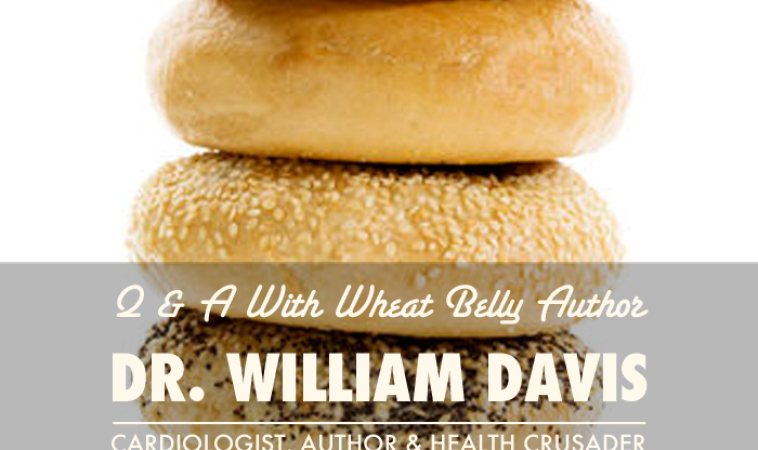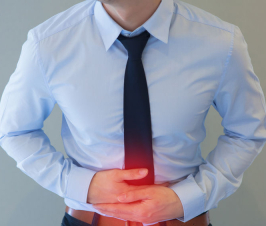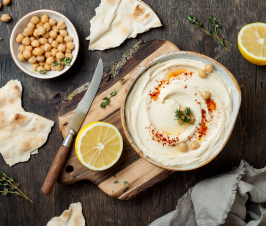Cardiologist, author, and health crusader
 Dr. William Davis is author of the New York Times #1 Bestseller, Wheat Belly: Lose the Wheat, Lose the Weight and Find Your Path Back to Health, the book that turned the nutritional world by storm by challenging the conventional wisdom of “healthy whole grains,” exposing the changes introduced into modern wheat by geneticists responsible for an astounding range of adverse health effects. He is also author of the NY Times Bestsellers Wheat Belly Cookbook, Wheat Belly 30-Minute (or Less!) Cookbook, and Wheat Belly Total Health.
Dr. William Davis is author of the New York Times #1 Bestseller, Wheat Belly: Lose the Wheat, Lose the Weight and Find Your Path Back to Health, the book that turned the nutritional world by storm by challenging the conventional wisdom of “healthy whole grains,” exposing the changes introduced into modern wheat by geneticists responsible for an astounding range of adverse health effects. He is also author of the NY Times Bestsellers Wheat Belly Cookbook, Wheat Belly 30-Minute (or Less!) Cookbook, and Wheat Belly Total Health.
NaturalPath sat down with Dr. Davis to talk nutrition, grains, and the gluten-free craze.
Wheat was once considered “the staff of life.” Why is wheat so bad for our health?
Wheat is the perfect obesogen: a food that makes you fat. There are several reasons for this effect.
There is a protein in wheat called gliadin that, upon partial digestion, yields small pieces (peptides) that bind to the opiate receptors of the human brain, just like morphine and other opiates. But the opiates that derive from wheat gliadin don’t make us “high”—they exert other mind effects, but especially hunger and addictive relationships with food. This is why, when people reject all wheat from their diet, they first experience a rather unpleasant opiate withdrawal syndrome (nausea, headache, fatigue, low mood) that lasts around a week, then followed by a wonderful freedom from hunger. After the initial withdrawal process is over, a common comment from people following the Wheat Belly lifestyle is, “I no longer obsess about food. In fact, I forget to eat.”
There are also components in wheat that block the action of the hormone leptin, the hormone produced by the liver in response to a full stomach. When you consume something made from wheat, this satiety signal is turned off, even after you have consumed all you need for sustenance. Another effect adding to weight gain is the carbohydrate unique to wheat, amylopectin A, that raises blood sugar higher, ounce for ounce, gram for gram, than white table sugar: two slices of whole wheat bread raises blood sugar higher than 6 teaspoons of table sugar. Blood sugar highs are followed by blood sugar lows about 90 to 120 minutes later. The blood sugar lows are accompanied by anxiety, mental fogginess, and hunger—you are hungry every 2 hours.
Combine all three of these effects and you have the perfect formula for weight gain. Understand this and you are freed from the weight gain and appetite-stimulating effects of wheat. It is also important for readers to understand that wheat is the seed of a grass, and grasses are genetically promiscuous, meaning that the seeds of other grasses—“grains”—overlap substantially. To enjoy the full power of this lifestyle, we therefore eliminate wheat and all other related seeds of grasses: we eliminate allgrains.
The gluten-free diet has become wildly popular in the United States. What are some common myths and misconceptions about going gluten-free?
Conventional advice says that cutting out grains could cause nutritional deficiencies but the opposite is true. Think about it: wheat and grain-based products are among the very few fortified foods, i.e., have multiple nutrients added. This is because grains contain compounds called phytates or phytic acid that are potent blockers of the absorption of minerals, especially iron, zinc, magnesium, and calcium. The phytate content, for example, of two slices of whole grain bread reduce iron absorption by 90%. This explains why wheat consumption is the second most common cause for iron deficiency anemia in the world, a condition that affects 2 billion people. There are other deficiencies that develop with wheat and grain consumption, especially vitamin B12. This is because of the common inflammatory and autoimmune damage to the cells (parietal cells in the stomach) that produce the proteins that allow B12 absorption.
For these reasons, when people eliminate wheat and grains, they witness levels of iron, zinc, magnesium, calcium, and vitamin B12 that goup, not down. Many people with iron deficiency anemia, for instance, can reverse the condition by saying goodbye to all wheat and closely related grains.
It’s also important to point out that we do not replace wheat and grains with jelly beans and soda pop. We replace them with nuts, seeds, meats, coconut oil, olives, olive oil, more vegetables and other healthy foods. By doing so, not only are we now able to absorb nutrients more effectively, we obtain the full range of vitamins, minerals, and other nutrients in truly healthy quantities.
In the Wheat Belly lifestyle, we never limit calories, portions sizes, or offer advice such as push the plate away. We simply eliminate this potent appetite stimulant and watch hunger disappear and pounds slip away effortlessly, while enjoying substantial health benefits, as well.
Most major food producers are now marketing gluten-free varieties of their products. Should we eat these foods or avoid them?
No, they are generally awful for health.
The amylopectin A of wheat and grains we’ve discussed raises blood sugar higher than nearly all other foods, even white table sugar. What foods raise blood sugar even higher than the amylopectin A of wheat? It’s a short list but includes cornstarch, rice flour, tapioca starch, and potato flour—the four most common ingredients used in gluten-free products. This explains why people who follow a “gluten-free” lifestyle gain weight (often substantial) and often in the form of inflammatory visceral fat, develop diabetes, and increase risk for hypertension, heart disease, cancer, and dementia. The zein protein residues in cornstarch can also activate autoimmune conditions, explaining why many people with celiac disease don’t enjoy a full return to health despite being “gluten-free.”
In the Wheat Belly lifestyle, we therefore go farther than being gluten-free: we are grain-free and avoid the gluten-free processed foods made with what I call “junk carbohydrates.”
What should consumers look for on labels of gluten-free foods?
I urge people to rely mostly on foodswithoutlabels: real, single-ingredients foods like green peppers and pork chops. If you choose a processed gluten-free foods, I tell people that they should never contain cornstarch, rice flour, tapioca starch, or potato flour–the four most common ingredients in gluten-free foods. Such ingredients send blood glucose sky-high, trigger small LDL particles that lead to coronary disease, provoke insulin excessively, add to insulin resistance, grow visceral fat, and distort bowel flora. Cornstarch, in particular, can be contaminated by the zein protein of corn that overlaps in immunogenicity with the gliadin protein of wheat and can trigger celiac disease and other autoimmune conditions.
When avoiding wheat and gluten, what are some of the healthiest grain alternatives?
None.
I advocate a lifestyle free of all seeds of grasses–“grains.” Grains, i.e., the seeds of grasses from the biological family, Poaceae, are largely indigestible. Wheat germ agglutinin in wheat, rye, barley, and rice, for instance, is completely impervious to human digestion, but wreaks havoc in its passage from mouth to toilet. The gliadin protein of wheat, rye, and barley is, at best, only partially digestible; if it remains intact, as much does, it provides the first step in the activation of the autoimmune process, allowing excessive “leak” of foreign substances, such as gram negative lipopolysaccharide and gliadin itself, into the blood and lymph systems.
No grain is without adverse effects on the humans foolish enough to consume them.
What are the first steps in embarking on a grain free lifestyle?
It’s really quite simple:
- Eat no wheat or grains, including those added to processed foods such as frozen dinners, seasoning mixes, soups, licorice.
- Eat real, single-ingredient foods that you can be confident have no grains—eggs, meats, fish, avocados, nuts, seeds, vegetables, fruit.
- Manage carbohydrates—this means not allowing unhealthy excessively carbohydrate-rich foods like candy or ice cream to dominate.
That last item—manage carbohydrates—is necessary because sugar, high-fructose corn syrup, and other unhealthy carb soures have proliferated in modern foods, and because so many modern people are diabetic, pre-diabetic, or need to lose a lot of weight. It is also a reminder to not replace wheat and grains with gluten-free products made with those junk carb ingredients. Managing carbohydrates properly (the strategies to do so are discussed in detail in Wheat Belly Total Health) will compound the benefits begun by wheat/grain elimination. This simple 3-step process holds the power to turn lives around, relieve people of literally hundreds of health conditions from common to rare, and set you back on the path to weight loss with none of the agony that typically accompany weight loss programs.
Grains are a large part of traditional American breakfasts. What is your favorite grain-free breakfast food?
Because I also reject the notions of limiting fat, saturated fat, cholesterol, and calories, I tell people to eat more whole eggs, meats with the fat, and other real, single-ingredient foods. For variety, however, as well as for entertaining and holidays, I have come up with ways to recreate pancakes, waffles, breakfast cereals, muffins and other familiar foods with no wheat, no grains, no gluten-free junk ingredients, no added sugars. This is how all Wheat Belly recipes were created so that people can have, for example, a big slice of cheesecake for breakfast, or several slices of pizza on the weekend.

















